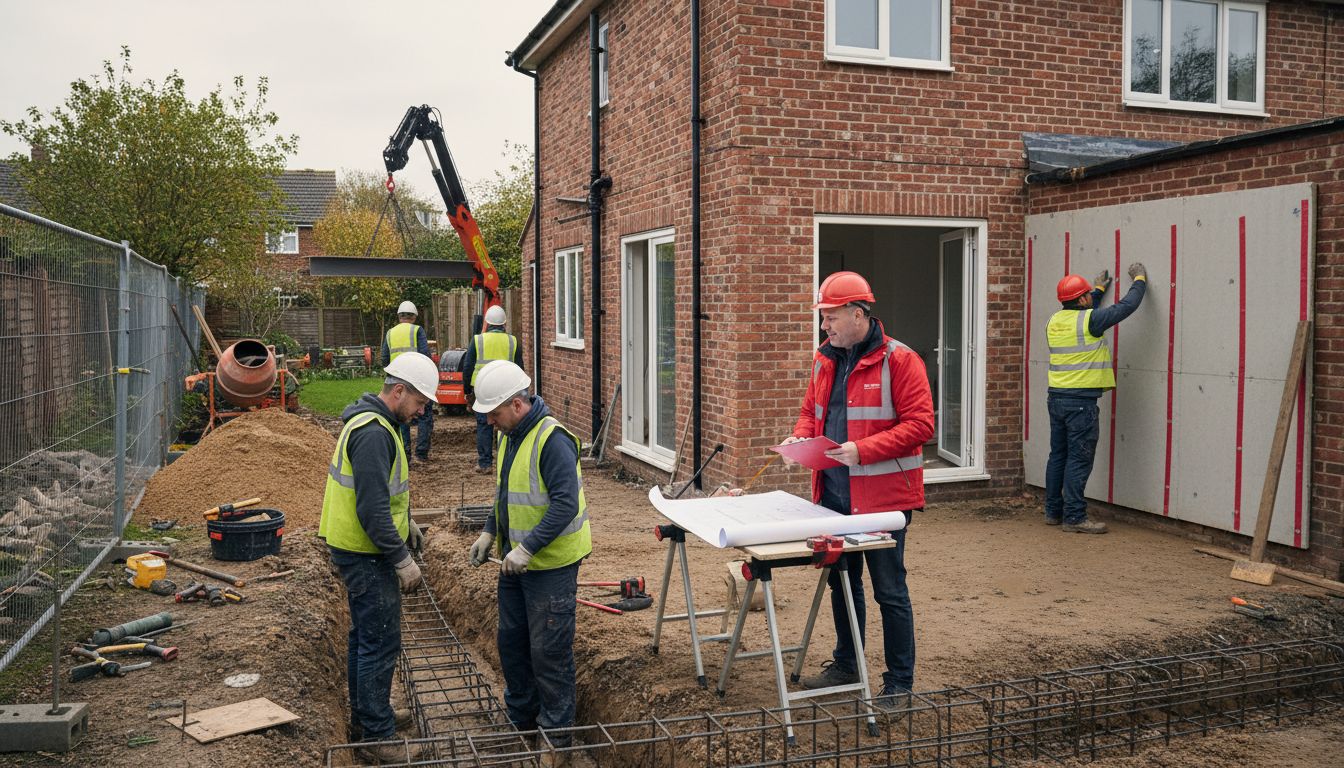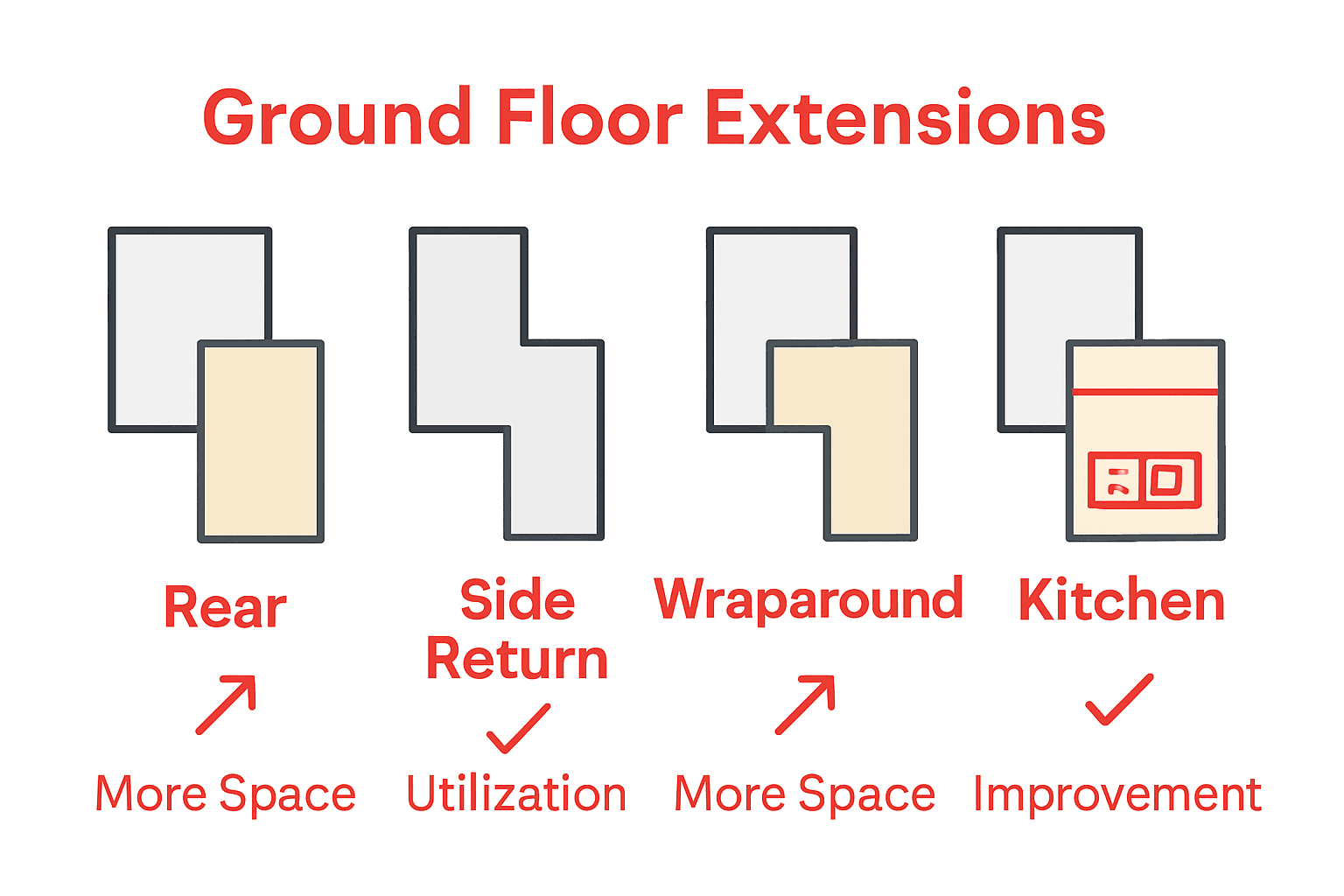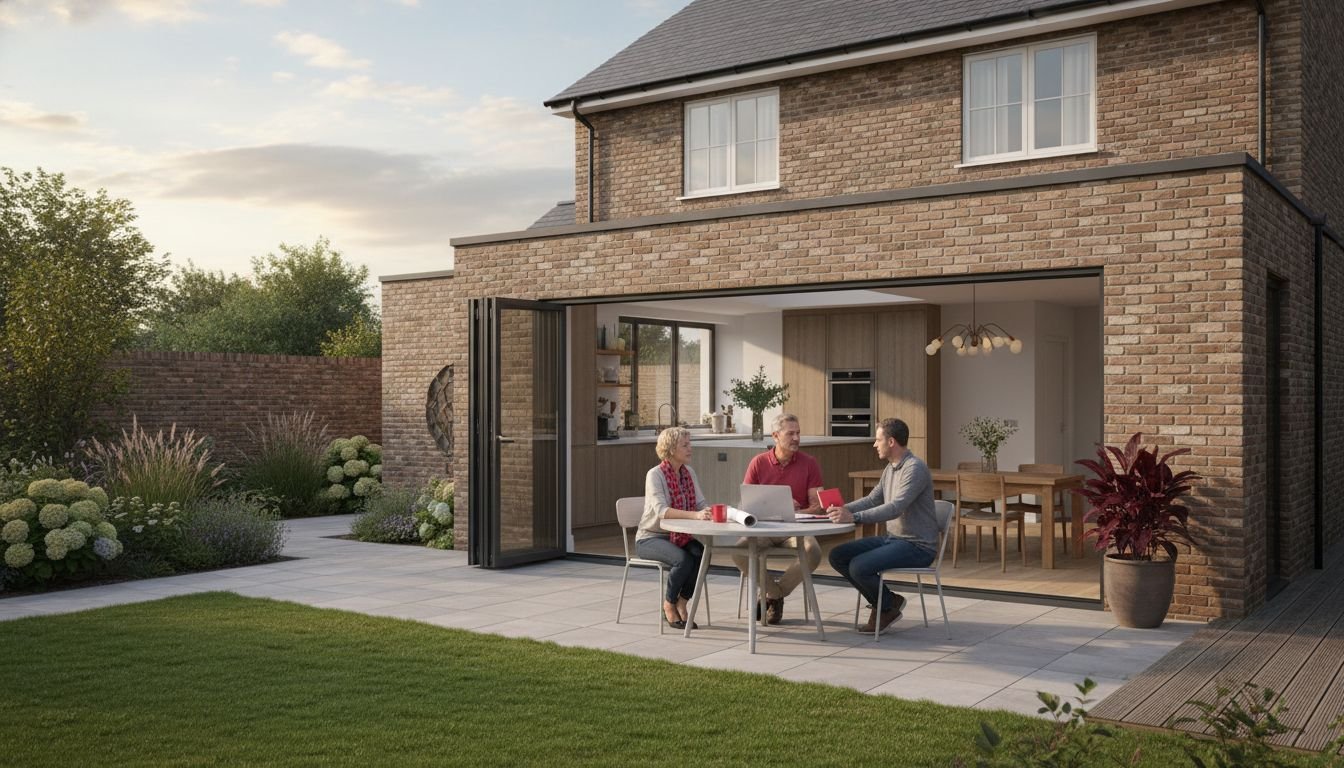More than half of UK homeowners plan to extend their homes rather than move, reflecting a strong trend toward adapting spaces to fit changing needs. Ground floor extensions deliver a practical way to add valuable living space, from brighter kitchens to open-plan living areas. Understanding what these extensions involve and how they can transform a home helps you make informed choices and maximise both comfort and property value.
Table of Contents
- Defining Ground Floor Extensions For Homes
- Types Of Ground Floor Extensions Explained
- Planning Permission And UK Legal Requirements
- Construction Process And Key Considerations
- Costs, Timelines, And Common Mistakes
Key Takeaways
| Point | Details |
|---|---|
| Ground Floor Extensions Enhance Space | These extensions expand horizontal living space, ideal for creating open-plan areas or additional functional rooms like home offices. |
| Planning and Permissions are Crucial | Check if your extension falls within Permitted Development rights or requires full planning permission, especially in sensitive areas or for listed buildings. |
| Construction Requires Detailed Planning | Follow a structured process that includes design, obtaining permits, and ensuring compliance with building regulations to avoid complications. |
| Budgeting and Timeline Management are Key | Typical costs range from £1,500 to £2,500 per square metre, with project timelines varying; careful planning can prevent common pitfalls. |
Defining Ground Floor Extensions for Homes
A ground floor extension transforms your home’s layout by expanding its horizontal living space at ground level. According to Mazo Architecture, this involves strategically enlarging the existing home’s footprint, typically to the rear or side, creating additional functional areas without modifying upper floors.
HomeBuilding highlights that these single-storey additions are particularly popular for enhancing key living spaces. Homeowners frequently use ground floor extensions to:

- Enlarge existing kitchens
- Create open-plan living areas
- Add functional spaces like home offices
- Improve natural light and connectivity with outdoor spaces
Ground floor extensions offer remarkable flexibility in design and purpose. Whether you want to create a spacious kitchen-diner, add a sunlit living room, or design a versatile multipurpose space, these extensions can dramatically improve your home’s functionality and aesthetic appeal. By working with experienced professionals on home extension design, you can transform your ground floor into a personalised, modern living environment that perfectly suits your lifestyle and family needs.
Types of Ground Floor Extensions Explained
Ground floor extensions come in several distinctive styles, each offering unique benefits for homeowners looking to expand their living spaces. Understanding these variations helps you choose the most suitable approach for your specific property and lifestyle needs.
The most common types of ground floor extensions include:
Here’s a comparison of the main types of ground floor extensions:
| Extension Type | Typical Placement | Main Benefits |
|---|---|---|
| Rear Extension | Back of property | Larger kitchen/diner Improved garden access |
| Side Return | Side passage | Opens cramped areas Better natural light |
| Wraparound | Rear and side | Maximum added space Highly flexible layout |
| Kitchen Extension | Kitchen area | Modern kitchen space Integrated dining/living |
- Rear Extensions: Extending living space at the back of the property, typically creating larger kitchen or dining areas
- Side Return Extensions: Utilising the narrow side passage to widen existing rooms, often transforming cramped spaces into open-plan layouts
- Wraparound Extensions: Combining rear and side extensions to create substantial additional floor space with maximum flexibility
- Kitchen Extensions: Specifically designed to enlarge and modernise kitchen areas, often incorporating dining and living zones
Designing your ground floor extension requires careful consideration of your home’s existing architecture and your specific requirements. By exploring different types of home extensions, you can discover innovative solutions that not only increase your living space but also enhance your property’s overall functionality and market value. Professional architects can help you navigate these options, ensuring your extension seamlessly integrates with your home’s existing design while meeting your unique needs.

Planning Permission and UK Legal Requirements
Planning permission for ground floor extensions in the UK involves navigating a complex landscape of legal requirements and local authority regulations. According to St Albans City and District Council, homeowners must carefully consider whether their proposed extension falls within Permitted Development rights or requires formal planning consent, particularly in sensitive areas like conservation zones or for listed buildings.
Most ground floor extensions can be completed under Permitted Development Rights, which typically allow:
- Rear extensions up to 3 metres for terraced houses
- Rear extensions up to 4 metres for detached and semi-detached homes
- Maximum height restrictions of 4 metres
- Extensions covering no more than 50% of the original property’s curtilage
However, several critical factors can trigger the need for full planning permission. These include:
- Extensions in conservation areas
- Proposals affecting listed buildings
- Projects exceeding Permitted Development size limits
- Alterations to the property’s external appearance
- Significant changes to the street scene
To ensure a smooth extension process, homeowners should consult the house extension approval process well in advance. Engaging with local planning authorities early can help you understand specific requirements, avoid potential legal complications, and streamline your home improvement project.
Construction Process and Key Considerations
Executing a ground floor extension requires meticulous planning and attention to critical technical details. According to St Albans City and District Council, key considerations during construction include ensuring proper foundation requirements, providing robust structural support, implementing effective thermal insulation, and maintaining strict compliance with building regulations to guarantee safety and energy efficiency.
The typical construction process for a ground floor extension involves several strategic phases:
- Initial site survey and ground assessment
- Detailed architectural design and planning
- Obtaining necessary building permits
- Site preparation and groundwork
- Foundation laying
- Structural framework construction
- Roofing and weatherproofing
- Internal fitting and finishing
Crucial technical considerations that demand professional expertise include:
- Soil type and ground stability assessment
- Drainage and water management
- Structural load-bearing calculations
- Thermal performance and insulation standards
- Electrical and plumbing system integration
- Acoustic and heat transfer considerations
To navigate these complex requirements effectively, homeowners should explore comprehensive project management workflows that help streamline the construction process, mitigate potential challenges, and ensure a successful ground floor extension that meets both aesthetic and regulatory standards.
Costs, Timelines, and Common Mistakes
Planning a ground floor extension involves carefully balancing budget expectations, realistic project timelines, and strategic preparation to avoid potential pitfalls. Typical ground floor extension costs can range significantly, typically between £1,500 to £2,500 per square metre, depending on complexity, materials, and location within the UK.
Project timeline considerations typically break down as follows:
- Initial design and planning: 4-8 weeks
- Obtaining permissions: 8-12 weeks
- Site preparation: 1-2 weeks
- Construction phase: 10-16 weeks
- Finishing and snagging: 2-4 weeks
Common mistakes homeowners frequently encounter include:
- Underestimating total project costs
- Failing to budget for unexpected expenses
- Neglecting comprehensive architectural planning
- Overlooking potential structural challenges
- Choosing contractors without thorough background checks
- Inadequate communication with builders and architects
To navigate these challenges effectively, homeowners should explore comprehensive extension project budgeting strategies that help manage financial expectations, prevent costly overruns, and ensure a smooth, well-executed ground floor extension project. Professional guidance can make the difference between a stressful renovation experience and a successful home improvement journey.
Transform Your Home with Expert Ground Floor Extensions
Understanding the challenges of planning a ground floor extension like navigating planning permissions or choosing the right design can feel overwhelming. You may be concerned about budget overruns, structural complexities, or simply how to maximise your living space effectively. At Reltic Extend, we specialise in helping homeowners across London and Surrey overcome these exact hurdles with tailored solutions focused on transparent pricing, full project management, and expert design advice.
Explore inspiring ideas and practical guidance in our Extension Inspiration & Ideas for Your Home | Reltic Extend to find the perfect fit for your lifestyle. If you want detailed insight into which option suits your property best, our Types of Home Extensions & Ideas | Reltic Extend provides clear comparisons and innovative designs. Ready to make your dream home a reality without stress or delay? Get started with confidence today by contacting us directly at Reltic Extend and let our experienced team support you every step of the way.
Frequently Asked Questions
What is a ground floor extension?
A ground floor extension is an addition to a home’s living space at ground level, typically expanding the existing footprint horizontally by extending to the rear or side of the property.
What are the main benefits of a ground floor extension?
Ground floor extensions provide flexibility in design, allowing homeowners to create larger kitchens, open-plan living areas, additional functional spaces like home offices, and improved connectivity with outdoor areas.
What types of ground floor extensions are available?
Common types include rear extensions, side return extensions, wraparound extensions, and kitchen extensions, each offering unique benefits and design possibilities for expanding living space.
Do I need planning permission for a ground floor extension?
Many ground floor extensions fall under Permitted Development rights, allowing certain dimensions without formal planning consent. However, factors like conservation areas or features affecting listed buildings may require permission, so it’s important to check with local authorities.





